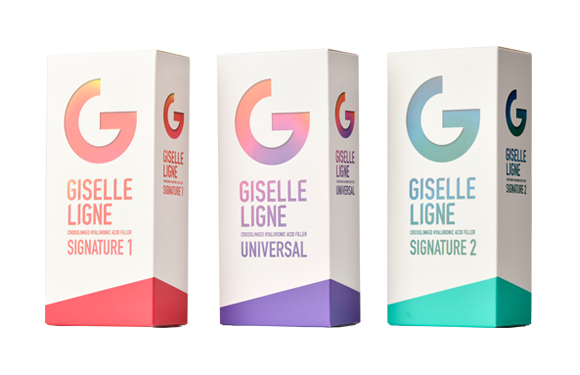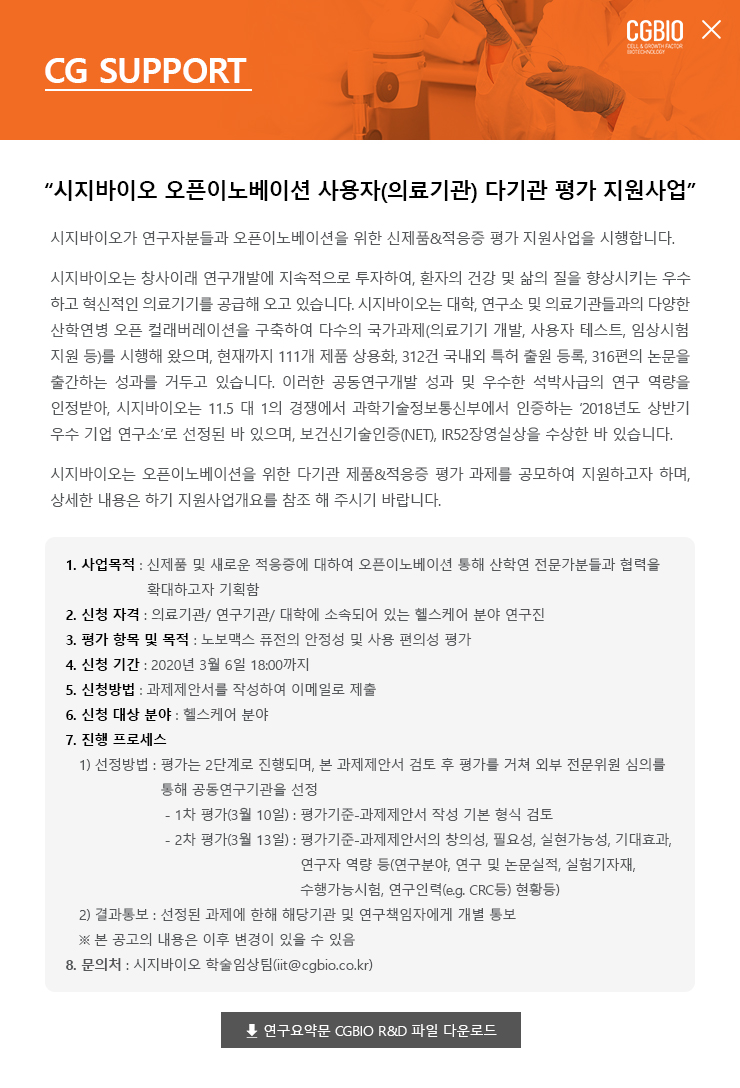


-
Description
GISELLELIGNE is a sterile, transparent gel of stabilized hyaluronic acid of non-animal origin with the addition of 0.3% lidocaine hydrochloride. The gel is presented in a graduated, pre-filled, disposable syringe.
-
Indications for use
GISELLELIGNE is a sterile, transparent gel of stabilized hyaluronic acid of non-animal origin with the addition of 0.3% lidocaine hydrochloride. The gel is presented in a graduated, pre-filled, disposable syringe.
-
Contraindication
1) Do not use of flowing cases.
- A patient with a bleeding disorder.
- A patient with a history of serious allergic reaction and hypersensitivity.
- A patient with a history of streptococcus disease.
- Anatomical areas active dermatopathology, inflammation or similar lesion.
- A patient with a history of hypersensitiveness to local anesthetics of the amid type, such as lidocaine
- A patient with history of facial keloid formation or hypertrophic scar
-
Warnings
- Do not inject GISELLELIGNE into blood vessel. This may cause localized superficial necrosis after injection in or near dermal vessels, such as the glabellar area. The chances of this happening are very small, but if it does happen, the complications can be serious, and may be permanent. These complications, which have been reported for facial njections, can include vision abnormalities, blindness, stroke, temporary scabs, or permanent scarring of the skin. If you have changes in your vision, signs of a stroke (including sudden difficulty speaking, numbness or weakness in your face, arms, or legs, difficulty walking, face drooping, severe headache, dizziness, or confusion), white appearance of the skin, or unusual pain during or shortly after treatment, you should notify your health care practitioner immediately.
- Defer use of GISELLELIGNE at specific sites in which an active inflammatory process(skin eruptions such as cysts, pimples, rashes, or hives) or infection is present until the process has been controlled.
- Injection site reactions (e.g., swelling, redness, tenderness, or pain) to GISELLELIGNE have been observed as consisting mainly of short-term minor or moderate inflammatory symptoms starting early after treatment and with less than 7 days duration in the nasolabial folds. Rare post- market reports of immediate post-injection reactions included site pain, the whole face and symptoms of hypersensitivity such as anaphylactic shock.
- Delayed onset inflammatory papules have been reported following the use of dermal fillers. Inflammatory papules that may occur rarely should be considered and treated as a soft tissue infection.
- Introduction of product into the vasculature may lead to embolization, occlusion of the vessels, ischemia, or infarction. Take extra care when injecting soft tissue fillers, for example inject the product slowly and apply the least amount of pressure necessary. Rare but serious adverse events associated with the intravascular injection of soft tissue fillers in the face have been reported and include temporary or permanent vision impairment, blindness, cerebral ischemia or cerebral structures. Immediately stop the injection if a patient exhibits any of the following symptoms, including changes in vision, signs of a stroke, blanching of the skin or unusual pain during or shortly after the procedure. Patients should receive prompt medical attention and possibly evaluation by an appropriate health care practitioner specialist should an intravascular injection occur
-
Precautions
- In order to minimize the risks of potential complications, this product should only be used by health care practitioners who have appropriate training, experience, and who are knowledgeable about the anatomy at and around the site of injection.
- Health care practitioners are encouraged to discuss all potential risks of soft tissue injection with their patients prior to treatment and ensure that patients are aware of signs and symptoms of potential complications.
- GISELLELIGNE is intended for single use only. Sterility is not guaranteed in the event of re-use.
- Do not re-sterilize. Do not use if the box or blister packaging is damaged or opened.
- The safety of GISELLELIGNE for use during pregnancy, in breastfeeding females or in patients under 18 years has not been established.
- GISELLELIGNE should be used with caution in patients on immunosuppressive therapy.
- Bruising or bleeding may occur at GISELLELIGNE injection sites.
- GISELLELIGNE should be used with caution in patients who have under gone therapy with thrombolytics, anticoagulants, or inhibitors of platelet aggregation in the preceding 3 weeks.
- After use, syringes and needles should be handled as potential biohazards. Disposal should be in accordance with accepted medical practice and applicable local, state and federal requirements.
- The safety of GISELLELIGNE with concomitant dermal therapies such as epilation, UV irradiation, or laser, mechanical or chemical peeling procedures has not been evaluated in controlled clinical trials.
- Patients should minimize exposure of the treated area to excessive sun, UV lamp exposure and extreme hot/ cold weather at least until any initial swelling and redness has resolved.
- If laser treatment, chemical peeling or any other procedure based on active dermal response is considered after treatment with GISELLELIGNE, there is a possible risk of eliciting an inflammatory reaction at the implant site. This also applies if GISELLELIGNE is administered before the skin has healed completely after such a procedure.
- Injection of GISELLELIGNE into patients with a history of previous herpetic eruption may be associated with reactivation of the herpes.
- GISELLELIGNE is a clear, colorless gel without particulates. In the event that the content of a syringe shows signs of separation and/or appears cloudy, do not use the syringe.
- GISELLELIGNE should not be mixed with other products before implantation of the device.
- A patient with currently active infection on face area.
- A patient with a tendency of hypertrophic cicatrix.
- The safety of GISELLELIGNE for the patient with a permanent insert such as calcium hydroxyapatite(CaHA) around nasolabial fold within 1 year has not been established in controlled clinical studies
- As with all transcutaneous procedures, GISELLELIGNE implantation carries a risk of infection. Standard precautions associated with injectable materials should be followed.
- The safety of GISELLELIGNE for the patient with history of facial keloid formation or hypertrophic scar has not been established in controlled clinical studies
-
Potential adverse events
- Site Pain
- Site edema
-
How supplied
Each box contains 1.0 mL or 3.0 mL prefilled with GISELLELIGNE. The box contains single-use sterile needles to be used only for injecting GISELLELIGNE, an instruction leaflet and a set of labels for patients that doctors can use in order to ensure traceability.
-
Shelf life and storage
Storage: Room temperature(2~30°C) away from direct sunlight and avoid freezing Shelf-life: 36 months For additional information, contact local sales representatives.
-
Shelf life and storage
(1) Attach needle to syringe
- ① Hold syringe and pull tip cap off the syringe.
- ② Hold the syringe body and firmly insert the hub of the needle (provided with the GISELLELIGNE package together) into the LUER-LOK end of the syringe.
- ③ Tighten the needle by turning it firmly in a clockwise direction until it is seated in the proper position.
- ④ Hold the syringe body in one hand and the needle cap in the other. Without twisting, pull in opposite directions to remove the needle cap.
(2) Instructions for Physicians
- ① GISELLELIGNE is injected using a 25G ½” 27G ½” or 30G ½” needle to volumize and contour the cheek for correction of mid-face volume deficit.
- ② Please check the expiry date printed on the label prior to use.
- ③ Prior to treatment, the patient’s medical history should be obtained, and the patient should be fully apprised of the indications, contraindications, warnings, precautions, treatment responses, adverse reactions, and method of administration. Patients also should be advised that supplemental “touch-up” implantations may be required to achieve and maintain maximum correction.
- ④ The patient’s soft-tissue deficiencies should be characterized with regard to etiology, distensibility, stress at the site, and depth of lesion. Pre-treatment photographs are recommended.
- ⑤ After ensuring that the patient has thoroughly washed the treatment area with soap and water, the area should be prepped with alcohol or other antiseptic. Prior to injecting, depress the plunger rod until the product flows out of the needle. If the needle is blocked, do not increase the pressure on the plunger rod. Instead, stop the injection and replace the needle.
- ⑥ After insertion of the needle, and just before injection, the plunger rod should be withdrawn slightly to aspirate and verify the needle is not intravascular.
- ⑦ After the first small amount of material has been injected into the patient, wait a full 3seconds to allow the lidocaine to take effect before proceeding with the rest of the injection.
- ⑧ The injection technique for GISELLELIGNE with regard to the angle and orientation of the bevel, the depth (subcutaneous and/or submuscular/supraperiosteal) of injection, and the quantity administered may vary depending on the area being treated. Injection of GISELLELIGNE too superficially (intradermally), or in large volumes over a small area, may result in visible and persistent lumps and/or discoloration.
- ⑨ With submuscular/supraperiosteal injection, the number of times the needle passes through the muscle should be minimized to reduce the risk of bruising. It is important to stop injecting before the needle tip reaches the level of the deep dermis to prevent material from being placed too superficially in the skin.
- ⑩ Correct to 100% of the desired volume effect. Do not overcorrect. The degree and duration of the correction depend on the character of the defect treated, the tissue stress at the implant site, the depth of the implant in the tissue, and the injection technique.
- ⑪ If immediate blanching occurs, the injection should be stopped and the area massaged until it returns to a normal color. Blanching may represent a vessel occlusion. If normal skin coloring does not return, do not continue with the injection
- ⑫ The area of lost facial volume should be lifted by the end of the injection. When injection is completed, the treated site may be gently massaged to mold the product to the contour of the surrounding tissue and assure that it is evenly distributed and conforms to the contour of the surrounding tissues. If overcorrection occurs, massage the area between your fingers or against an underlying superficial bone to obtain optimal results.
- ⑬ With patients who have localized swelling, the degree of correction is sometimes difficult to judge at the time of treatment. In these cases, it is better to invite the patient back to the office for a touch-up treatment.
- ⑭ After the initial treatment, an additional treatment may be necessary to achieve the desired level of correction. The same procedure should be repeated until a satisfactory result is obtained. The need for an additional treatment may vary from patient to patient and is dependent upon a variety of factors such as mid-face volume deficit severity, skin elasticity, and dermal thickness at the treatment site.
- ⑮ The physician should instruct the patient to promptly report any evidence of problems possibly associated with the use of GISELLELIGNE
(3) Incompatibility
Since hyaluronic acid may cause precipitation from quaternary ammonium and chlorohexidine such as benzalconium chloride that is disinfectant, prevent storing this product together with such products or letting this product come in contact with surgical equipment that use such substances.
